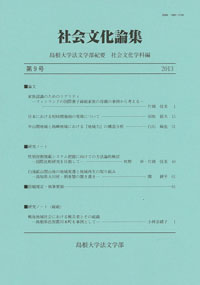島根大学法文学部
ISSN:1880-2184

ダウンロード数 : ? 件
この文献の参照には次のURLをご利用ください : https://ir.lib.shimane-u.ac.jp/7129
社会文化論集 7
2011-03-19 発行
SYMLOGの評定項目に関する妥当性の検討
Construct validity of the SYMLOG ratingform : A confirmatory factor analysis approach
黒田 文
ファイル
内容記述(抄録等)
The purpose of this study was to test the construct validity of the SYMLOG ratingform by using confirmatory factor analysis. The ratings were originally developed by Bales (1969), and consist of 26 Likert-type items arranged on a five-ordered response set ranging from “never” to “always.” In the SYMLOG system, the three-dimentional space is designed to assess the characteristic behaviors of any group of individuals in interaction with each other. The spatial names of the dimensions are U-D (for Upward-Downward), F-B (for Forward-Backward), and P-N (for Positive-Negative).
While the prior reseach has recommended to use the simple (non-combinative) ratingitems for the Japanese because of the cultural difference, few research studies have sought to explore the fruits of the multi-level observation usingthe combination of the adjective ratingitems based on those dimensions. Confirmatory factor analysis revealed that fit indices for the three-factor model (hypotheseized the three-dimentional space) were statistically superior when compared with the one-factor model and the two-factor model even if the combinative items were used. The findings indicate that the combinative adjective items in the SYMLOG ratings could be working for research in the Japanese setting.
While the prior reseach has recommended to use the simple (non-combinative) ratingitems for the Japanese because of the cultural difference, few research studies have sought to explore the fruits of the multi-level observation usingthe combination of the adjective ratingitems based on those dimensions. Confirmatory factor analysis revealed that fit indices for the three-factor model (hypotheseized the three-dimentional space) were statistically superior when compared with the one-factor model and the two-factor model even if the combinative items were used. The findings indicate that the combinative adjective items in the SYMLOG ratings could be working for research in the Japanese setting.
Other Article
